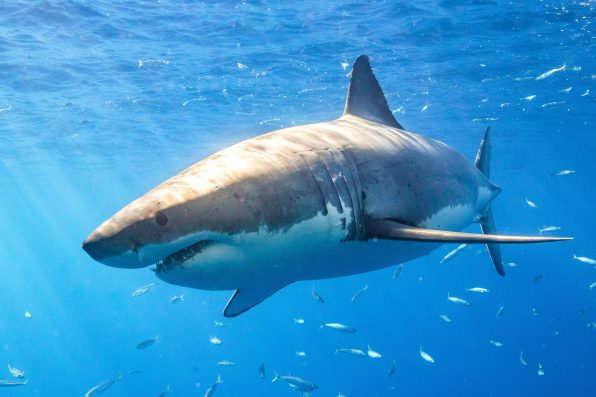Every Single Year, Great White Sharks Off The Coast Of California Gather In A Remote Meeting Spot That’s Been Dubbed The White Shark Café

Every year, great white sharks that usually inhabit the waters off the coast of California will gather in a remote spot in the Pacific Ocean halfway between Hawaii and Baja California. The meeting spot is about the size of Colorado and has been dubbed the White Shark Café.
For a while, scientists didn’t know why the sharks congregated in that specific area, but they’ve been slowly piecing together the puzzle.
Researchers from Stanford University and the Monterey Bay Aquarium led a scientific expedition that answered many questions about the café.
The great whites travel for about a month at depths ranging from 660 feet to several miles to reach the café. They make the trip in order to feed on small fish, squid and phytoplankton.
“It’s the largest migration of animals on Earth—a vertical migration that’s timed with the light cycle,” said Salvador Jorgensen, a research scientist with the Monterey Bay Aquarium. “During the day, they go just below where there is light, and at night, they come up nearer the surface to warmer, more productive waters under the cover of darkness.”
Wherever the prey goes, the sharks will follow, which explains their deep-diving behavior, especially the V-shaped “bounce dives” of males.
Previously, it was thought that the café region was an oceanic desert that harbored very little life, raising the question of why great sharks would go there at all. Thanks to decades-long research, new information about the mysterious spot was finally uncovered.
Barbara Block, a professor of marine sciences at Stanford University’s Hopkins Marine Station, was the one who came up with the name “White Shark Café.” At the time, she had been studying the migration patterns of North Pacific great whites after fitting them with electronic tags.
Between 1999 and 2000, Block and her team tagged six sharks off the coast of California. They monitored their movements for six months.

shanemyersphoto – stock.adobe.com – illustrative purposes only, not the actual shark
Four of the sharks headed southwest toward Hawaii and stayed in a remote section of the ocean. They also took deep dives in the location. Over the years, the researchers realized that large numbers of great white sharks were migrating offshore.
In 2018, Block and her team tracked great whites to the café to collect data about the environmental conditions and marine life there. The researchers found an oasis of microscopic algae and communities of marine animals.
However, they still didn’t know why the sharks chose to seek out food there every year instead of just hunting in their usual habitats.
Last fall, Block and Jorgensen led a team that tagged 37 great white sharks. The following spring, they embarked on the research vessel Falkor to observe the sharks in the café. They used underwater remote vehicles and information about water temperature, salinity, and environmental DNA to better understand the café.
“We found a high diversity of deep-sea fish and squids (over 100 species), which, in combination with observations made by the ROV and DNA sequencing, demonstrate a viable [food source] to support large pelagic organisms such as sharks and tunas,” Block said.
In 2016, the International Union for Conservation of Nature and UNESCO’s World Heritage Center recommended that the White Shark Café be designated as a World Heritage site. It is hoped this will happen sometime in the near future.
Sign up for Chip Chick’s newsletter and get stories like this delivered to your inbox.
More About:Animals





